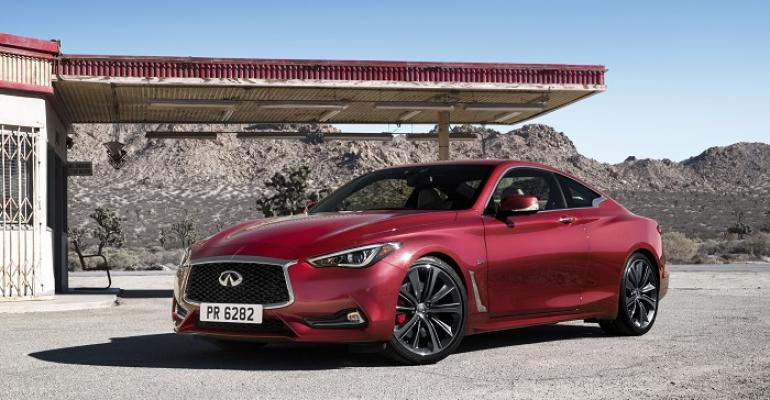DETROIT – One year after its concept debuted here, the Infiniti Q60 production car is unwrapped today at the 2016 North American International Auto Show.
Visually the production coupe, which will give buyers a choice of three engines and two suspensions, is similar to the concept.
Its surfaces have the same look of “fluid movement,” in the words of Infiniti’s executive design director Alfonso Albaisa. The Q60’s shapely sheet metal, achieved through deep-body stamping processes, is meant to transmit the performance potential of the vehicle, the luxury brand says.
Performance is amped up over the outgoing Q60, which makes 330 hp from its VQ V-6, a 15-time Wards 10 Best Engines winner.
The new Q60 will get the same 400-hp, 3.0L twin-turbo V-6 announced last month for the refreshed ’17 Q50, the sedan version of this coupe.
The all-new Nissan engine, which carries the VR designation, also comes in a 300-hp version. Q60 buyers who don’t need 300 or 400 hp can select a 208-hp, 2.0L direct-injected and turbocharged 4-cyl.
Horsepower figures are for engines using premium fuel. Infiniti says a 3%-5% output reduction should be expected with regular unleaded.
The 2.0T is a Daimler design already in use in the Mercedes-Benz C-Class and Infinitis sold in Europe, but assembled by Nissan in Decherd, TN. Not surprisingly, this engine is estimated to provide the best combined fuel efficiency at 24 mpg (9.8 L/100 km).
Combined fuel economy for the 300-hp and 400-hp V-6s is 23 mpg (10.2 L/100 km) and 22 mpg (10.7 L/100 km), respectively. All figures are for engines mated to a 7-speed automatic transmission.
The outgoing Q60, which was rebadged from G37 three years ago when Infiniti changed its vehicle nomenclature, averages 22 mpg at best with its 3.7L VQ V-6 paired to a 7-speed automatic. Both the all-wheel-drive ’15 Q60 and 6-speed manual version net 20 mpg (11.8 L/100 km) combined.
Infiniti doesn’t yet have fuel economy figures for the ’17 Q60 with its available AWD system that splits torque 50/50 between the front and rear axles.
Buyers can choose between a standard suspension system, which Infiniti says has low levels of road noise and vibration with direct and linear handling response, or a new suspension system with electronically adjustable shock absorbers.
With the latter, dubbed Dynamic Digital Suspension and standard on Sport grades of the Q60, drivers can dial in Sport or Sport+ levels of comfort and dynamic responsiveness via a mode selector in the interior.
The inside of the car was crafted around a driver’s-glove theme, Albaisa says, noting it means the “driver is always comfortable and the cabin is tailored to them.”
The base-model Q60 has standard aluminum trim and an available black wood trim, while Sport and Premium grades get carbon-fiber “highlights.” A silver-glass fiber accent is in the interiors with white or red leather seats.
For a “truly engaging sports coupe experience,” Infiniti says it has re-tuned its steer-by-wire system, Direct Adaptive Steering.
DAS, which promises to transmit driver input to the wheels faster and with fewer steering corrections than a mechanical system, was not a favorite of many reviewers of the Q50 on which it debuted for its unnatural steering feel and tendency to make the vehicle wander or swerve from its lane.
Now DAS, available only with V6-equipped Q60s, is said to enhance steering feel and feedback. DAS offers six driver-selectable steering modes in the ’17 Q60: Customize, Standard, Snow, Eco, Sport and, on select models, Sport+.
Rack electronic power steering is standard on V-6 models, while 4-cyl. Q60s receive speed-sensitive hydraulic electronic rank-and-pinion power steering.
Infiniti says the Q60’s exterior dimensions have grown from the outgoing model’s, while aerodynamics also are improved via an active grille shutter on V-6 models, which closes when engine cooling is not needed. Front fender vents that route air out of the engine bay also help the Q60 achieve a 0.28 coefficient of drag.
Noise, vibration and harshness reduction inside the cabin is credited to more suspension insulation, stiffer cross-members and vibration-dampening wheel spokes.
Driver and passenger preferences for temperature, seating positions, audio-visual features and navigation can be set via Infiniti’s newest-generation infotainment system, dubbed InTuition central control.
Infiniti Q60 U.S. sales finished 2015 well below year-ago levels, down 49.0% to 3,949 from 7,740 in 2014.
In WardsAuto’s Luxury Specialty car segment, where the Q60 lives, the BMW 4-Series was the No.1-selling model last year, with 46,082 units delivered.





